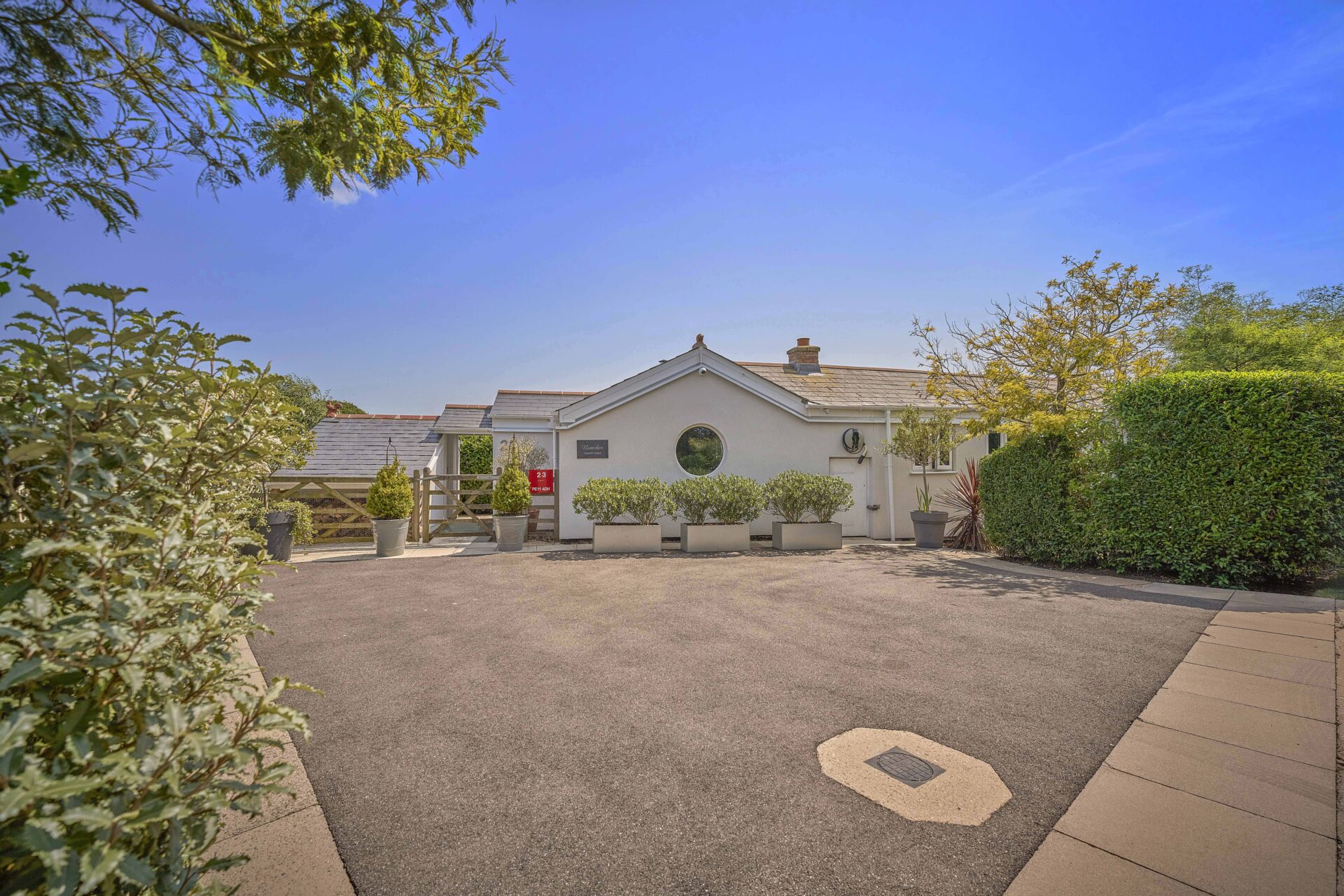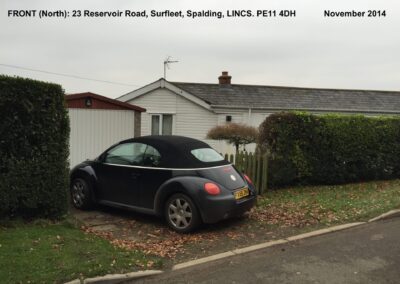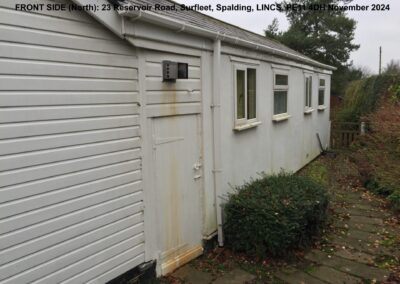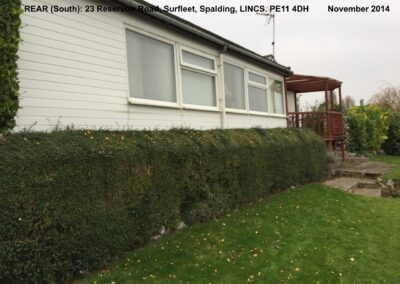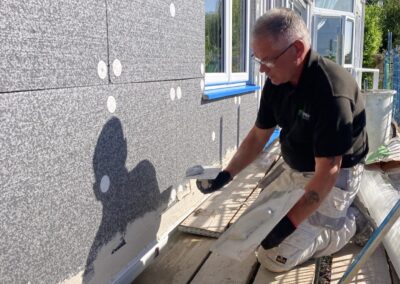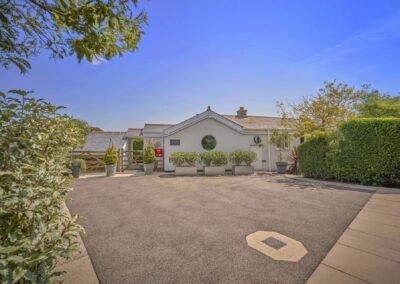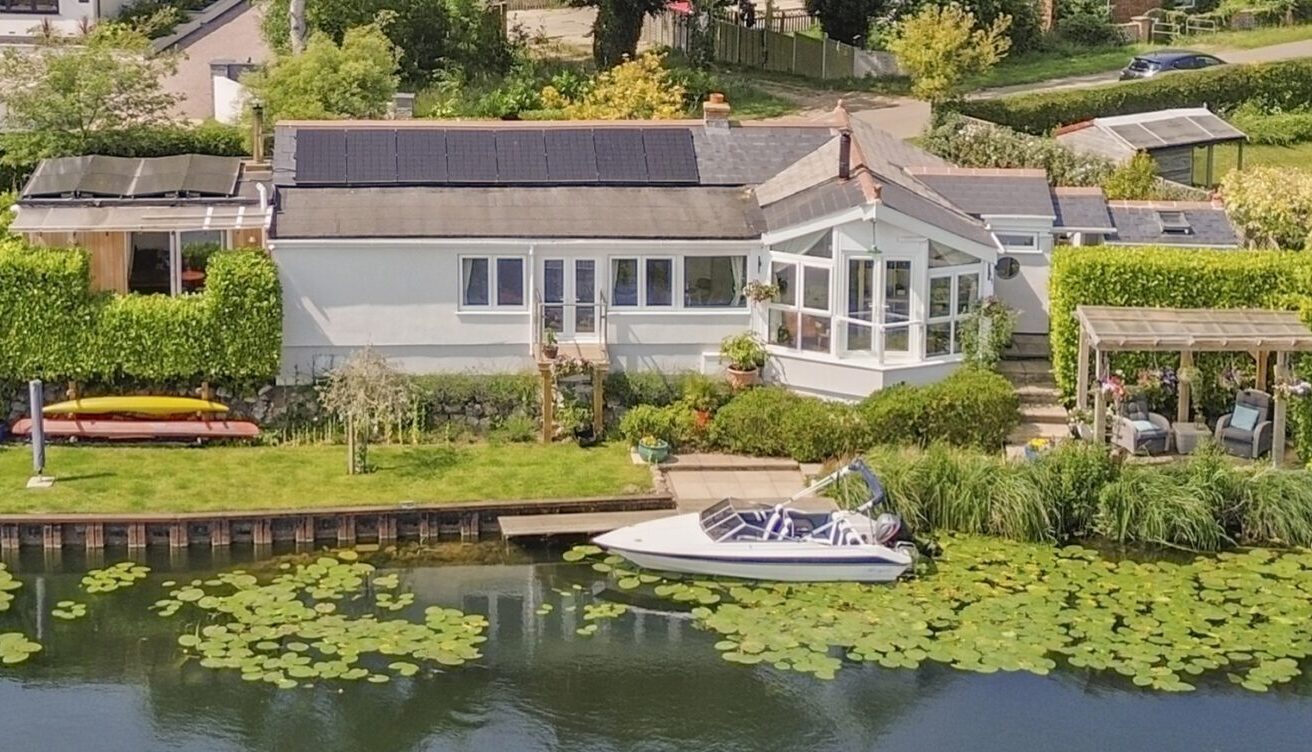INCA Case Study: NUMBER 23 Lincolnshire
NUMBER 23
Project Type: Refurbishment
Building Type: Low Rise, Residential
Architect: Dr Jerry Harrall
System Designer: EWI Pro
Installer: J.L. Ingram Builders
System & Finish: EWI Pro EWI
U-Value Before: 2.00 W/m²K
U-Value After: 0.15 W/m²K
INTRODUCING NUMBER 23
Number 23 aim was to adapt a1960’s hard to heat, hard to treat, oil-fired 3bed dwelling to a fossil-fuel-free home.
In so doing, it has delivered an advanced building performance standard. A standard that offers a national retrofit benchmark, one that is low tech, cost effective and replicable.
The property is providing post-occupational performance data, is available as a retrofit resource, one that contributes long-term in-use building performance data placed within the public realm as an open-resource.
Another emerging output is a ‘True Cost of Ownership’ (TCO) model. A second years in-use building performance data is to be collected for veracity. A prerequisite requirement in driving down TCO is to avoid the encumbrance and reliance on mechanical means for heating and ventilation i.e. no gas or oil central heating system, no ground source heat pumps, no air source heat pumps, no MVRH and no mechanical ventilation. Thus, eradicating maintenance, servicing and eventual capital replacement of equipment, in perpetuity.
Included within Number 23’s adaptation techniques, is a passive solar design approach, incorporating renewables, energy storage facility, allied with significant fabric upgrade, incorporating a natural ventilation regime with low Volatile Organic Compounds (VOC) materials specification, producing exceptional Indoor Air Quality metrics.
BACK-STORY
Purchased in 2015, the aspiration for Number 23, from the very beginning, was to explore to what extent it would be possible through retrofit, to achieve close to the energy efficiency standards of the new owners (Harrall’s) former new-build home, a 2005 RICS Sustainable Building Award Winner, ‘87 Gedney Road’, Long Sutton, Lincolnshire.
The self-built former home, is a case study in this authors PhD. 15years ago that home achieved a ‘zero-heated’ standard, was fossil-fuel-free in operation and naturally ventilated.
The results of Number 23’s retrofit are detailed below and offered as just one way in which it is possible to achieve high energy efficiency standards without resort to mechanical intervention for either heating nor ventilation. This is not the only way to achieve these standards.
Number 23 is located on 52degrees latitude, 9miles from the north sea in the south Lincolnshire Fen, and sits next a river. High relative humidity and unchecked prevailing winds are some of the physical characteristics the designer was required to consider.
THE SOUND OF EWI
External Wall Insulation (EWI) Reduces Noise Pollution….an unexpected consequence!
An unexpected consequence of installing external wall insulation (EWI) and silicone render to Number 23, was the calm and stillness that resulted inside the home. The reduction in outside noises heard in each room, from wind, passing cars and even bird song, have been transformational, creating a constant level of quietness and tranquillity throughout the home.
To measure the contrast in sound levels inside and outside Number 23, an iphone App @decibelmeter was used. Noise levels were measured on a gusty autumn day, outdoor sound levels varied between 98dB and 58dB, the APP recorded an average of 64dB, described as “conversation in office”. Inside the home, sound levels remained relatively constant at 38dB, spiking occasionally due to human activity, the App described these levels as “quiet rural location” and “library”.
It is apparent at Number 23 that the combination of expanded polystyrene boards and silicone render have provided discernible soundproofing.
What are the physical characteristics of EWI that reduce sound transmission through an external wall?
As has been experienced at Number 23, EWI provides a reasonable level of resistance to airborne sound transmission, a process known as sound attenuation. This is the action of acoustic waves moving through the air and slowing over time. This reduction in the intensity of acoustic waves is known as attenuation.
Expanded polystyrene (EPS) while it has reasonable sound attenuation qualities, it is not the best material for noise control, nor for noise mitigation. Generally, the denser the material, the more effective it is at blocking sound. Denser materials have more mass, which make it more resistant to the vibrations of sound waves. The overall effectiveness of bespoke sound proofing materials, depends on a combination of density, elasticity, thickness, and the specific sound frequencies being addressed.
By contrast, polystyrene foam is lightweight and while relatively rigid, its closed-cell structure lacks the mass and density to effectively block sound transmission to the same degree as say a concrete block.
AIR PRESSURE TEST
On completion of the retrofit work at Number 23, the measured Air Pressure Test (APT) recorded 6.8m3/hr/m2 @ 50 Pa. This is a 3point improvement from the APT undertaken on 26/11/2015 which measured 9.8m3/hr/m2. The reduced air leakage from the property can be attributed to the laying of new solid oak floor boards and the installation of the external wall insulation and silicone rendering system.
An Air Pressure Test (APT) calculates the air tightness of a building’s fabric also known as its ‘air permeability’ or ‘leakage’ rate. This is a measure of the air that escapes the building via uncontrolled means. This does not include leakage from trickle vents, extract fans nor passive stack vents, these are sealed up during the testing process. Air Permeability is the measure of airtightness used in the UK Building Regulations Approved Document L.
Improving the airtightness, reducing air permeability of new and existing buildings, assists in reducing heat loss. Air permeability, is usually quoted as cubic metres of airflow per square metre of total surface area at an induced pressure of 50Pascals, i.e. m3/hr/m2 @ 50 Pa.
A useful adage used within the construction industry is, ‘build tight, ventilate right’.
Understanding fabric performance is essential in avoiding unintended condensation issues resulting from reduced fabric air filtration following the application of an external wall insulation system.
INTERSTITIAL CONDENSATION
Interstitial condensation occurs when warm, moist air from inside a building penetrates into the fabric of a structure and meets a cold surface, where it cools, reducing its ability to carry water vapour and increasing the risk of condensation forming within the construction.
Installing the EWI system has reduced the risk of interstitial condensation from forming within the structure, the dew-point is moved closer to the external surface of the external insulated.
Surface condensation is prevented from forming on internal wall surfaces the warm side of the insulation which will always be above the dew point temperature.
Interstitial condensation can occur between building construction interface layers of roofs, walls and floors. Persistent interstitial condensation within the building fabric can lead to degradation of materials, increased risk of mould formation and a reduction in air quality.
At Number 23, its modified external walls with the installation of external wall insulation and silicone rendering. A Condensation Risk Analysis has evaluated the likelihood of interstitial condensation in the modified wall construction. These calculations demonstrate compliance with ‘UK Building Regulation Part C’.
The analysis concluded that Number 23’s external wall detail, avoided critical surface moisture, with no danger of mould growth. On the incidence of interstitial condensation, it concluded there was no risk of condensation forming at any interface in any month.
THERMAL BRIDGING
Thermal bridges (aka cold bridges) are thermally weak junctions with significantly higher heat transfer than surrounding materials. These junctions form a bridge between inner and outer surfaces e.g. window jamb, where paths of least resistance for heat transference, can result in up to 30% of total building heat loss. As a consequence, thermal bridges are at risk of internal surface condensation formation, potentially leading to mould growth, presenting a health risk.
Installing EWI at Number 23 has introduced an uninterrupted layer of insulation over potential thermal bridges
Thermal bridging can be greatly reduced in existing buildings and almost completely removed in new buildings by installing an EWI the building. Therefore, overlaying the existing thermal bridges (such as those at external wall to party wall junctions) with insulation removes any significant thermal bridge, reduces heat loss and prevents condensation from forming.
Careful design detailing is required at junctions such as those at window and door reveals, roof eaves and verges and where the EWI system starts close to ground level.
WHY EXPANDED POLYSTYRENE?
EWI was considered an integral measure in enveloping the building in a blanket of insulation while attending to detailing to improve air tightness. It was this latter consideration that in part led to the decision to apply internal wall insulation. Attention to junction detailing, reduced fabric heat loss while reducing risk of interstitial condensation were the primary drivers in the dual approach of IWI and EWI.
At Number 23, EPS was used rather than a mineral wool insulation batt.
This decision also highlights a personal disposition, a bias on the part of the architect/owner, one that guided the material choice.
As a teenage plasterer’s apprentice, the author spent many hours in attics, laying fibreglass quilt insulation and filling bathroom studwork. Memories are still fresh of the resultant itching, likened to insects crawling under the skin, for days on end.
Setting aside a personal bias, what follows is a more objective view regarding the two insulation products, MW and EPS. Both materials have comparable performance characteristics when the full contingent of characteristics are considered i.e. R-value, moisture uptake, Life Cycle Analysis, durability, recycling, compression, GWP, handling and cost.
Recycling is a shared characteristics for re-use as an insulation product. This process of recycling and reuse for both MW and EPS can be repeated indefinitely.
Another common tenet, is they both have a relatively high R-Value, indicating a relatively high resistance to heat, a good insulation characteristic. However, EPS’s R-value is generally higher than that of MW, in some cases, higher by up to 40%. In other words, you can use less EPS to achieve the same insulation value as MW.
Neither MW nor EPS can be categorised as having high sound insulation performances characteristics, although when combined with a cladding solution, there are marked reductions in sound transfer through walls.
Where the MW and EPS products do vary significantly is their fire resistance, moisture uptake, handling and unit cost.
It is widely acknowledged that MW has a higher Fire Rating than EPS, which is the subject of much sector scrutiny at present. For this reason, MW is seen as a lower risk product above certain building heights.
By contrast, MW’s moisture uptake is significantly higher than that of EPS, a performance now highlighted by the inclusion of Condensation Risk calculations in the Building Regulations.
Another difference are the health concerns with MW’s predisposition for releasing fibres with the potential to cause respiratory issues continues to be the subject of health and safety precautions.
Perhaps one of the most significant market drivers, is that EPS is half the cost of MW.
INDOOR AIR QUALITY (IAQ)
The soon to be released ‘Future Homes Standard’ (FHS) claims it aims to improve indoor air quality (IAQ) by requiring energy-efficient ventilation systems (Part L) and higher airtightness (Part F) standards in new homes.
Neither solution, individually nor combined, will address the unlegislated issue of poor IAQ in UK buildings caused by VOC’s. This author advocates treating the root cause rather than treating the symptoms as legislated for in the US IAQ. Number 23 attempts to address what constitutes good IAQ in a retrofitted home.
Volatile Organic Compounds (VOC’s)
At Number 23 recorded HCHO (Formaldehyde) average daily levels are 0.030mg/m3 (WHO Guidelines 0.1mg/m3 safe threshold) and Total Volatile Organic Compounds (TVOC) are 1.0 ppm, WHO guidelines are 3.0 to 5.0 ppm.
International Agency for Research in to Cancer (IARC) has classified formaldehyde (HCHO) as a human carcinogen.
Particulates PM2.5 & PM10
At Number 23, measuring the combined PM2.5 & PM10, recorded an average daily threshold is 33µg/m³.
The World Health Organization (WHO) recommends that 24-hour average limits of 15 µg/m³ for PM2.5 and 50 µg/m³ for PM10.
Measured PM2.5, PM10 at Number 23 are below the WHO thresholds.
Formaldehyde HCMO
Average HCMO concentrations recorded in Number 23 over 12months is approximately 0.03 mg/m³ with minor fluctuations ranging from 0.02 to 0.06 mg/m³. Daily variations in recorded formaldehyde levels appear to correlate with household activities from early morning to evening with levels returning to a steady 0.03mg/m3 overnight.
Measured HCHO at Number 23 is below the WHO thresholds.
SOLAR REFLECTIVITY
An underrated and not much discussed constituent of the silicone top coat, Clay-White colour RAL 9003 used at Number 23 is Titanium Dioxide (TiO₂)
The presence of TiO2 increases solar reflectivity, which helps the home repel excess heat. Mediterranean European buildings white facades and even roof’s feature ubiquitously as an architectural characteristic for its cooling effect. TiO₂ can also withstand weathering and keep whites brighter longer, making it easier to maintain internal temperatures and keep cooling costs down.
Number 23 welcomes the probable benefits to this home from TiO2
LIFE CYCLE ANALYSIS (LCA)
A comprehensive Life Cycle Analysis (LCA) calculation was commissioned by the designer/occupier using an independent third party. The calculation was undertaken in accordance with the RICS Whole Life Carbon Assessment Standard (Version 2) and EN 15978.
It is inevitable that the UK construction sector will embrace Life Cycle Analysis (LCA) in providing a comprehensive approach to assessing and thus reducing the environmental impact of buildings throughout their entire lifespan. LCA helps identify areas for improvement in material selection, construction processes, and building operations, leading to more environmentally responsible and cost-effective buildings. This aligns with growing regulatory pressure, client demands for transparency and the broader goal of achieving the Governments net-zero goals.
It’s incumbent on our sector to begin the task of familiarising ourselves with the methodology and its new terms, phrases and metrics. Number 23 plays its part in beginning that task.
At Number 23, both embodied and operational Whole Life Carbon (WLC) were calculated.
EMBODIED & OPERATIONAL A-C: Production, Construction, Use and End-Of-Life Phases
The Whole Life Carbon (WLC) total for Number 23, assessed over a 60-year period and including electric vehicle (EV) charging, is calculated at 2,179 kgCO₂e/m² GIA, or 214 tonnes CO₂e in total. This equates to an annualised carbon intensity of 36 kgCO₂e/m²/year.
However, 42% of that total is attributed to onsite EV charging 915kgCO2e/m2.
Therefore, for the purposes of this appraisal and making meaningful comparisons, Number 23’s WLC value excluding EV charging, of 1,256 kgCO₂e/m² or 123 tonnes CO₂e and 21 kgCO2e/m2/year are the benchmark values.
It was useful to learn that if Number 23 had been demolished and rebuilt as a new home, its WLC is estimated at 4,800 kgCO₂e/m², or approximately 470 tonnes CO₂e, four times the carbon from retrofitting. Choosing to retain and retrofit the original structure has avoided 256 tonnes CO₂e.
When excluding the EV charging and the solar PV & battery storage system, the WLC increases by 14%, rising to 1,464 kgCO₂e/m² GIA or 143 tonnes CO₂e. This scenario highlights the significant carbon reduction benefits of the solar PV and storage system in mitigating approximately 20 tonnes CO₂e over the building’s life cycle.
EMBODIED A1-A5: Construction, Material Production, Transportation and Installation
AKA ‘Upfront Carbon’ ‘cradle to practical completion stage’
Upfront Carbon at Number 23 accounts for 20% of the total WLC when Solar PV & Battery Storage are included and EV Charging are excluded, which equates to 376 kgCO2e/m2 GIA or 37 tonnes CO2.
Excluding the Solar PV & Battery Storage, the Upfront Carbon equates to 258 kgCO2e/m2 GIA or 25 tonnes. Adding PV, Solar and battery have contributed a third of the Upfront Carbon.
OPERATIONAL B6: Energy for Heating, Lighting & Building Services
During the Operational phase of Number 23, the WLC total, including all electricity, space heating & water and EV charging equates to 948 kgCO2e/m2 or 93 tonnes and 16kg/CO2/m2.
Excluding the EV charging, the Operational carbon over a 60-year period is 378 kgCO2e/m2 or 37.4 tonnes with an annual carbon intensity of 6.3 kgCO2e/m²/year. which is 21% lower than the UK NZCBS best-practice threshold of <8 kgCO2e/m²/year.
Significantly, EV charging represents 71% of Number 23’s WLC Operational carbon.
60% of the WLC Operational carbon (excluding EV charging) is for space heating with wood burning which is 353 kgCO2e/m2 or 34 tonnes equating to 5.9 kgCO2e/m2/yr
36% of the Operational carbon has been mitigated by the onsite Solar PV Array Generation over 60 years by 590 kgCO2e/m2 or minus 58 tonnes.
Number 23’s embodied carbon performance warrants describing as exceptional, the LCA metrics surpass the Low Energy Transformation Initiative (LETI) 2030 Design Target (<300 kgCO₂e/m² A1-A5) sitting comfortably in Band A.
The home also surpasses the RIBA 2030 Built Target (<625 kgCO₂e/m² A1-5, B1-5, C1-C4) and outperforms the current Pilot UK Net Zero Carbon Buildings Standard (NZCBS) (<270 kgCO₂e/m² A1-A5)
Its operational emissions of 6.3 kgCO₂e/m²/year significantly surpasses the UK NZCBS best-practice of <8 kgCO₂e/m²/year.
EWI & IWI FIRST!
From Number 23 there is a strong case to be made that the lowest environmental retrofit action with the highest impact on building running costs is EWI & IWI.
EWI is only 3.2 % of the Total Upfront Embodied Carbon (811 kgCO2e) while IWI is less at 3% (759 kgCO2e)
However, the application of both EWI and IWI resulted in approximately a 90% reduction in heat loss through the wall, from an uninsulated wall at 2.00W/m2K to a super-insulated wall 0.15W/m2K.
ANECDOTAL FEEDBACK
Post retrofit feedback includes a discernible overall better thermal comfort with more stable internal air temperature ranges. This winter’s use of logs was significantly fewer and for shorter duration of periods with heat being held longer.
Sound attenuation from the EWI is such that traffic noise is significantly reduced.
Overall energy costs have reduced with the introduction of 4.7kWhpeak of pv’s and subsequently the 13.7kWhr Tesla battery installation.
Number 23 is now testing the market, with the property for sale, attracting a premium value promoting the As-Built EPC and other building performance characteristics.
SUMMARY
For the owner, the romance of heating with wood is waning quickly.
In the light of the IAQ and LCA metrics recorded at Number 23, there is measured evidential data to warrant revisiting the wisdom of woodburning in contemporary homes for reasons of health and operational carbon.
Furthermore, while a comprehensive analysis of True Cost of Ownership is incomplete, the data gathered thus far, strongly implies, that reduced reliance on fossil fuels, mechanical means for ventilation and heating, have contributed to a healthier living environment, while reducing the home’s impact on the wider environment.
An unexpected consequence of installing EWI, has been its concomitant effect in sound attenuation, adding another layer of health-giving enhancements.
Number 23’s measured performance upgrades include; 60point increase in SAP 94A from 34’F’, 86% less energy consumption, Operational Carbon 21% lower than the UK NZCBS, reduced VOC’s and particulates, much lower than WHO thresholds.
Choosing to retain and retrofit the original structure has avoided 256 tonnes CO₂e. It was useful to learn that if Number 23 had been demolished and rebuilt as a new home, its WLC is estimated at 4,800 kgCO₂e/m², or approximately 470 tonnes CO₂e, four times the carbon from retrofitting.
Number 23’s LCA highlights a strong case that the lowest carbon expenditure retrofit action with the highest positive impact on building performance is EWI & IWI. The application of EWI and IWI resulted in a 90% reduction in heat loss through the external walls, but only added circa 3% to the buildings Whole Life Carbon.
Finally, Number 23 plays its part in beginning the task in providing an evidential case study in which the Life Cycle Analysis methodology, its new terms, phrases and metrics are usefully introduced.
this project may have a legitimate claim to being the UK’s most energy efficient whole house retrofit.

